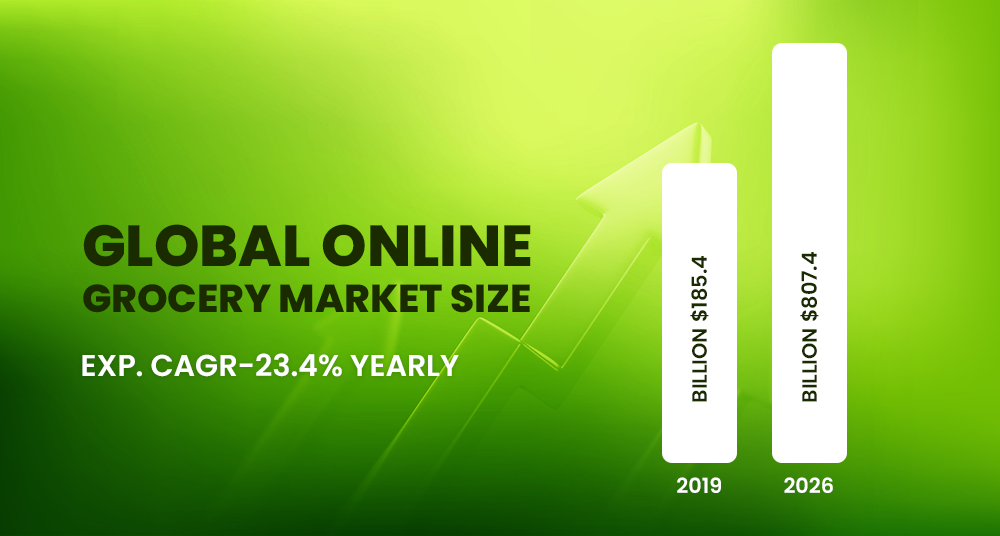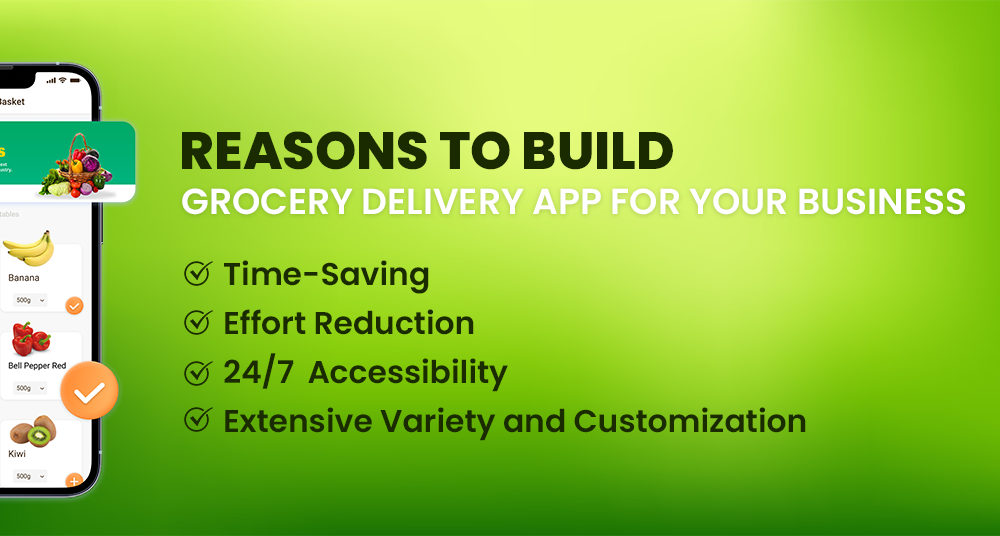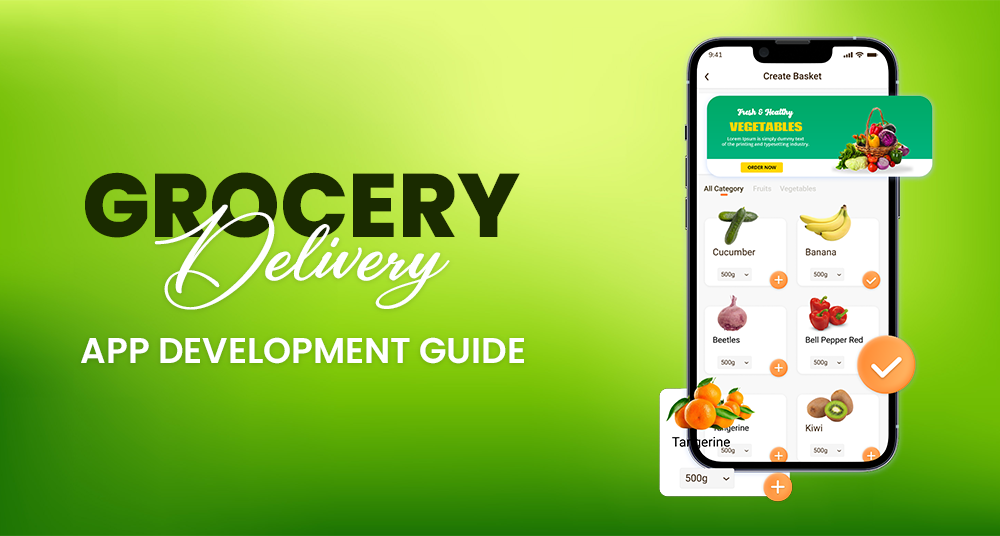The grocery store business has even joined the internet age. With the rise of grocery delivery apps, our regular shopping habits have significantly changed. When we buy groceries online, they can be brought right to our door in a few hours, and we never have to leave the safety of our houses. The number of people looking for grocery delivery apps has grown like crazy, and this article gives a full rundown of how it works.
Market Trends

With a value of more than $185.04 billion in 2019, the global online grocery market is expected to grow at a rate of 23.4% per year until it reaches $807.04 billion in 2026. This exponential rise shows that more and more people are buying things online.
One of the main things that has caused this change is the COVID-19 outbreak. Lockdowns and other forms of social distance made online food shopping more popular. Most people polled in 2020 said they used delivery services more and bought more food online than before the epidemic.
Soon, there will be a lot of new changes in the food service business. New technologies like driving cars and drone deliveries could change the operations of grocery store delivery, making service faster and more efficient. Customers who care about their health are buying more organic and health-focused things, which are also suitable for specialized food delivery services.
Why Grocery Delivery App?

Apps that bring groceries to customers’ doorsteps have entirely altered how people buy necessities. In addition to providing many advantages to consumers and grocery stores, these apps also have a positive environmental impact.
Here is a thorough examination of these benefits:
Time-Saving
The ability to save time is among the main advantages for users. Instead of spending hours traveling to and from the grocery store, navigating aisles, and standing in checkout lines, users can finish their shopping in a few clicks.
Effort Reduction
The physical strain associated with grocery shopping is eliminated by these apps, which is especially helpful for the elderly, disabled, and people with hectic schedules.
24/7 Accessibility
Unlike physical stores, users can shop conveniently with online grocery apps since they are available 24/7.
Extensive Variety and Customization
Customers can access more products than they might find in their neighborhood stores. Also, based on your past purchases, many apps will provide suggestions.
Things To Keep in Mind While Developing Grocery Delivery App
To make grocery shopping more accessible and enjoyable for users, a good grocery delivery app needs many features. The following are some essential components for these apps to succeed:
Design
The application should have a straightforward, user-friendly interface that makes navigating it easy, even for inexperienced users. Products are organized intuitively, search functions are user-friendly, and the checkout process is simple.
Design for Responsiveness
Whether you are on a desktop, tablet, or mobile phone, the app should look and work the same regardless of the type of device you are using.
Efficient and Quick
A user-friendly app with quick loading times and seamless transitions between sections is essential for keeping users engaged and avoiding frustration.
Order Status Updates
From order processing to delivery, users should be able to follow their orders in real-time.
Estimated Delivery Times
Giving precise estimated delivery times makes it easier to manage users’ expectations.
Delivery Staff Tracking
Being able to keep tabs on the whereabouts of delivery staff can provide users with an additional degree of comfort and security.
Factors to Consider in Grocery Delivery App Development
Several critical factors must be considered in grocery delivery app development to ensure its success and sustainability. Here are some key considerations:
- Demographics: Understand the age, gender, income level, and other demographic factors of your potential users to tailor the app’s features and marketing strategies.
- Preferences and Behavior: Analyze shopping patterns, preferred product types, and the frequency of purchases to customize the app experience.
- User Needs and Expectations: Identify what your target audience values most, whether it’s price, quality, variety, or delivery speed.
- Data Protection: Implement strong encryption and secure protocols to protect user data, including personal information and payment details.
- Regular Updates and Audits: Conduct security audits and updates to safeguard against new vulnerabilities and threats.
- User Trust: Establishing and maintaining user trust is crucial, and robust security measures are vital.
Problems that come up when making grocery delivery app
Developing a app like bigbasket comes with its own set of challenges that need to be addressed effectively:
- Robust Infrastructure: Make sure that the backend of the app can handle a lot of users at once without crashing or slowing down.
- Load Balancing: If you want to spread traffic evenly across servers, use load balancing.
- Dynamic Inventory Management: Set up systems that update your inventory in real-time to show how much you have in stock.
- Integration with Suppliers: Easy integration can help you keep the proper inventory.
- Unique Value Proposition: Make your app stand out by offering something special. This could be a different price, a more comprehensive range of products, a better user experience, or different delivery options.
- Understanding Competitor Strategies: Look at the strengths and weaknesses of established players to spot threats and opportunities.
What Makes a Grocery Delivery App Successful?
The following are essential features that every grocery service app should have. Let’s take a closer look at each of these points:
A User Interface That is Easy to Use
The style of the app should be clean and easy. A design that is too busy or hard to understand could turn people off. With good search and filter choices, users should be able to find what they’re looking for quickly. Adding more search tools and options, like category, price, brand, etc., improves the user’s experience. It’s essential to switch between the app’s different features easily. Lifesavers may be tools with clear signs and paper trails.
Several Different Ways to Pay
The more payment options you offer, the bigger your possible customer base will get. There are many options here, from old-fashioned cards and digital wallets to newer ones like UPI and, very rarely, cryptocurrency. We put a high priority on safe transactions. Ensure the payment method is safe and reliable so your users will trust it. The checkout must be simple and quick so customers keep their items in the box.
Real-Time Tracking Transparency
If customers can see exactly where their order is at all times, they are more likely to be happy and believe you. Customers can better plan their days when you give them an ETA, or estimated arrival time, for your delivery. Maps for real-time tracking could improve the experience by making it more lively and exciting.
Customizing Push Messages
We can make messages more practical and less annoying by looking at what users like and what they’ve bought. Notifications about important events, like sales, special deals, or changes to the state of an order, should be sent out regularly to keep people current. Users should be able to pick which alerts they want to get so spam doesn’t get sent.
Help for Customers
You can meet the needs of your users by giving them help in a variety of ways, like through chat, email, and phone calls. You can make users happier by promising quick responses to their questions or complaints. A well-organized help area or FAQ can help users quickly find answers to common issues.
These features make the user experience much better if they are implemented carefully and quickly. This can help keep customers and make your grocery delivery app successful in the competitive market.
How to Make an App for Grocery Delivery?
You need to take some critical steps to make a grocery delivery app like Grofers that works well, is easy for people to use, and has much power. A full description of these steps can be found here:
Make Plans and Do Research for the Market
What do your users like, how do they buy things, and what problems do they have? Learn as much as you can about them. Check out the shopping service apps to see what works and what doesn’t. What makes your app different from its peers?
Needs are Looked At
Prepare a list of all the features and functions you desire in your app based on what you have learned about the market. Check out the technical details, like the platform (Android, iOS, or both), the technology stack, and third-party connections.
The First Step in the Development Process
The goal of user interface and experience design should be to give end users a nice place that is easy to get around. Many things go into this design process, from the colors and fonts to how the user moves through the site. Make a model of the app that works to get a sense of how it is laid out and how it works. You can use tools like Adobe XD or Figma for this.
Making Apps for Phones
The parts of a program that users see and interact with are written as part of front-end development. Create the app’s core by handling databases, writing server code, and adding any needed APIs. Pick suitable computer languages, platforms, and tools based on what you need.
Testing for End Users
Five, complete testing as part of quality assurance (QA) to ensure the program has no bugs. This includes testing for functionality, speed, usefulness, and security. Get feedback from a small group who might use the product to find any problems with its work.
The Launch
After much testing, put your app on the app stores (iOS Software Store for iOS and Google Play Store for Android). Keep an eye on how well the app does and how people react to it after it comes out.
Marketing and Dealing With the Public
You can get your app out there with the help of digital marketing, social media, working with influencers, and other things. Improve your app’s ranking in app stores to get more people to see and download it.
Updating and Repair
Update the app by adding new features, changing old ones, and making it run better based on what users say and new technology. Always be there for users to help them with any technology issues they may be having.
Giving Users More Ways to Analyze Data
Use analytics to find out what they like and don’t like. You should add more services or benefits based on what people want and what the market does.
By following these steps, you can ensure that your grocery delivery app is well-designed, functional, and meets the needs of your target audience.
Having Trouble Making a Grocery Delivery App ?
Managing transportation, making sure orders happen on time, dealing with things that go bad quickly, and having a solid supply chain are all problems that need to be solved when making a shopping delivery app. To overcome these problems, you must carefully plan and ensure everything goes smoothly.
Here are a few of the most critical problems and how to solve them:
Overcoming Logistics Problems
Coordinating different orders and routes to ensure groceries are delivered on time and correctly. The answer is using cutting-edge transportation management tools to improve delivery plans and ways. AI and ML can also be used to figure out the best methods and shipping times.
Why being on time for deliveries is important
Traffic, inclement weather, and other unanticipated events can all cause delivery delays. Use real-time tracking to make route changes and add a backup period to your arrival estimates. Another way to keep customers from getting too excited is to let them know how their delivery is going.
How Hard It Is to Handle and Store Grocery That Goes Bad Quickly:
Foods like meat, cheese, fruits, and veggies must be stored and handled uniquely. The answer is to ensure supply cars have the proper insulation and cooling systems and set up strict quality control processes. Workers who handle fragile goods should also be taught how to care for them properly and regularly.
Steady Supply of Products
Ensuring a steady and reliable supply of products is especially important during busy times or unplanned events like pandemics. Keeping a solid supply line going is one problem. To ensure you always have enough stock, you should build trusting relationships with several providers. A flexible method for handling the supply chain is suggested so that you can better adapt to changes in demand.
Integration with Local Merchants Difficulty:
Working with local grocery stores and connecting their stock systems to the app might be challenging. The suggested answer is an expandable and flexible integration system that can talk to the stock management systems of different shops. It is also essential to build solid partnerships and keep lines of communication open with local shopkeepers.
Problems with the user experience:
It took a lot of work to make an app that people who need to be tech-savvy could understand and use. It is best to have an app style that is simple and easy to understand. User testing with a large group of people will help ensure the app is easy for everyone to use.
Protecting Data:
Protecting users’ personally identifiable information and financial data threatens data security and privacy. Following data protection guidelines, regularly updating security measures, and establishing solid online defenses are good options.
Challenges of customer service:
Customer service and support challenges are answering questions, dealing with complaints, and solving problems quickly and correctly. The answer is to create a dedicated customer service team and give people several ways to get in touch, such as through live chat, email, and the phone. AI-powered chatbots can also quickly answer questions that are often asked.
Software scalable:
The ninth issue is making the software scalable, which means making it so that it can handle more people and sales without slowing down. A flexible design and online services should be considered during the app’s creation to ensure it can take more users and sales. People who make shopping delivery apps can make one that stands out by anticipating these issues and then planning how to address them.
Grocery Delivery App Development Cost Estimates in 2025
The cost of developing a grocery delivery app varies depending on several factors. It primarily depends on the app’s complexity, features, platform (iOS, Android or both) and development team rates. Basic apps with basic features like user registration, product listings, and payment integration can cost between $10,000 and $25,000. However, more advanced apps with features like geolocation, real-time tracking, multiple payment options, and admin panels to manage your store can range from $25,000 to $80,000 or more. In addition, ongoing maintenance and updates add to the overall cost.
It is very important to work with experienced developers who understand your specific requirements to give you an accurate cost estimate for your grocery delivery app. Factors such as customization, scalability, and security measures also affect the final price.
Conclusion
Finally, there is an excellent chance for grocery delivery app development in today’s fast-paced business world. New tools and the need for ease have led to many new ideas. It takes work to turn an idea into a popular app, though.
To succeed in this project, you must know much about user experience. In today’s competitive app market, your product needs to be reliable, easy to use, and suited to the specific needs of your customers. You’ll need a robust system that can handle supply chain operations and store processes and an easy-to-use design and interface to make this work. It’s also essential to use the right tools. Choosing the right tech stack and adding advanced features like AI for route optimization and personalized ideas are all critical for the app to work well and grow.
The food service business constantly changes because customers’ tastes and habits shift. As these changes affect product offerings, delivery options, and payment methods, apps that can adapt will stay ahead of the rest. As the market grows, more and more chances may open up for developers and business owners in the shopping delivery app area.
Those who can get past the problems, keep an eye on how technology changes, and keep their focus on the customer are likely to win. You’re not just making an app when you make a food delivery service. People use it every day. Because there is so much room for creation and progress, now is an exciting time to work in this field.





